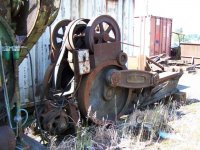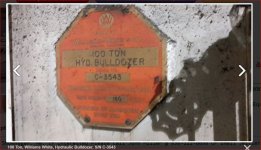I agree with Warren about the quality and overall visual effect of the old photos. Lugging around a "dry plate" camera, tripod, glass plates, and flash powder were quite a job in itself. Nothing electronic or automatic about the old cameras. Not even a "light meter". It was up to the photographer to determine settings for lens aperature, and shutter speed was not even a setting with a spring that could close the shutter at a precisely measured time interval.
Almost 40 years ago, when I worked in Paraguay, I saw street photographers at work in Asuncion (the capital of Paraguay). In those days, the Paraguayan government was a dictatorship, and people were required to get permits with photos for all sorts of things. Poor people needing these permits or simply wanting a picture to send to a relative or as a keepsake, would use the street photographers. This was strictly a sunny weather operation. The street photographers had what, at first glance, appeared to be the old wooden cased "dry plate" cameras. On closer examination, their ingenuity became apparent. Someone had found that a modern 35 mm single-lens reflex camera body could be grafted onto a large wooden box. The box was, in actuality, a portable mini-darkroom. The photographer loaded a piece of film into the camera, then took the picture in the manner of using the camera, with the f-stop and all the other features. Once the pictures were snapped, the photographer stuck his arms into two black cloth sleeves with drawstrings or got under a black cloth draped off the back of the wooden box. The top of the box had a sliding shutter, and there was a piece of red plastic. Inside the box were pans of chemicals, and all that was needed to develop black and white film. The red plastic on top of the box made a "darkroom safe light" when the sliding shutter on top of the box uncovered it. Making the actual prints of the photos was done using natural sunlight. Drying of wet photographic paper was done by stringing up twine between anything handy. Most of the photographers worked in a square near the railroad station, and they did a brisk business with poor people who had come to the capital for reasons of getting a permit, or simply wanted to have a photo taken. I've never seen anything like those street photographers, before, or since.
Another memory is stirred up by this side-discussion as well. When I was a kid in Brooklyn, an occasional photographer would come walking down the main shopping street. This was in the mid 50's, and it was still very much a street of mom-and-pop stores rather than big chain stores. The photographer walked a pony with a fancy saddle, and had the camera on its tripod over his shoulder, and a box of photo supplies and order pad in a leather case hung off the saddle. He chose the shopping street as mothers with kids and especially grandmothers "from the old country" could be counted upon to be in abundance there. Grandmothers who had emigrated from Eastern Europe loved the idea of seeing their precious grandchildren on a pony. The photographer usually found a blank wall to use as his backdrop and would use dry plates in his camera. It was the era of cash transactions in the stores, and cash was paid to the photographer. The hardest part of his job, I think, was getting kids to sit still on the pony as for kids in Brooklyn, being up close to a live pony was quite a novelty.
Another memory of my early childhood was having a family picture taken. We went to a photographer's studio. He had the old dry plate camera with the wooden body, and got under a black cloth hood. We kids were told to stand absolutely still and smile and the usual "watch the birdie" and "say cheese" were said a few times. We were also threatened with things that, today would get a parent in the cross hairs of child protective services if we did not freeze in place and quit giggling and fidgeting. It seemed to take forever to get just the right picture. Class photos in grade school were much the same process, same type of camera, only we had the teachers threatening us with being hauled into the principal's office, notes home to parents, all the while we kids were giggling and gigging each other in the ribs to produce jumping and laughter and yelps. Photos were a production back then, and a bigger deal. We had "Brownie" Kodak cameras, and Mom had a huge double-lens reflex camera with a "ground glass" screen on top where she could see the image through a duplicate lens to the one the camera used. I was always fascinated by the way the two lenses were geared together to produce simultaneous images. Mom, not to malign her memory, was a perfectionist and had a short fuse for us kids not cooperating when she wanted to compose a photo. To us, it was a license to kid around, poke each other, make jokes and be kids. To Mom, it was just short of a capital offense, and we'd hear about the cost of film, the luxury of being able to take photos, about how rough the rest of the world had it and similar. Mom lived to be 100 and was taking digital photos at every opportunity and got computer savvy enough to send them and receive them.
I used to take a 35 mm camera with me on the overseas jobs, and this limited the number of pictures I could take. I would bring the exposed rolls of film to "Fotomat", and never knew, until I saw them a few days later, how my photos came out. I paid for errors in taking pictures- underxposed, overexposed, blurry, etc.
I am one of those people who is old enough to marvel at digital photography and continue to marvel as digital photography has been grafted into cell phones. To me, it is the stuff of science fiction and comic strips come into reality. It seems too simple and too easy ! My old 35 mm Konica camera has not been used in ages and the electronics in it gave up the ghost. It does not pay to repair, assuming I could find anyone to do the repair. It's been overseas with me, on jobs, up on the high steel, down inside hydro turbines, in ships' engine rooms, on motorcycle trips and all over with me and later on, with my wife as well. Too old a friend to toss, and it does not eat anything, so it sits in a closet with its extra lenses and flash unit. Being able to know what a photo will look like, and scratch it and try again with the digital cameras is incredible to me. No taking film in to be developed, no waiting, no additional charges for developing the film (unless a person wants real photos made from the digital images). To an old dinosaur like me, it is still amazing stuff, and I suppose I am somewhere in the ranks of those "grandmothers from the old country" marvelling at a photographer with his pony in that regard. I appreciate the Shorpy images all the more, knowing something of the times and people in some of those images, and knowing a bit about what it took to take those photos.













